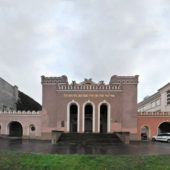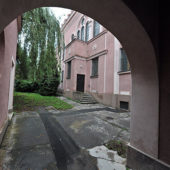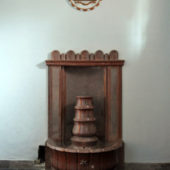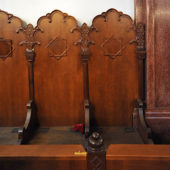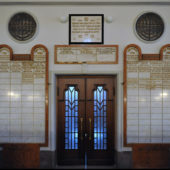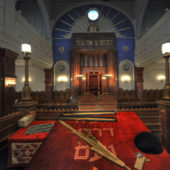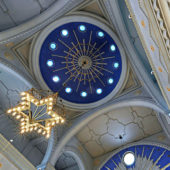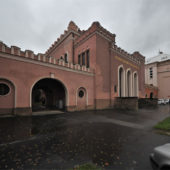Built to serve Kosice’s pre-World War II Jewish community of more than 12,00, this 800 seat synagogue is now used only on special occassions.
The first Jews settled in Kosice in 1843 yet they have lived in the Slovakian region since the 11th century. By the 14th century, nearly 800 lived in Bratislava, most of whom were engaged in commerce and money lending which were among the few occupations open to them. Two notorious blood libels occurred in Slovokia for which Jews were blamed. In 1494 Jews were burned at the stake in Trnava and in 1529 in Pezinok, 30 Jews were burned at the stake. Subsequently, after the battle of Mohacs in 1526, Jews were expelled from all major towns of Slovakia.
During the late 17th century and early 18th century, Jews began returning to Slovakia, and established communities. However, they were in constant conflict with locals and were banned from many trading industries. Under the rule of Joseph II, Jews were granted many civil liberties and their livelihoods were enhanced. In 1683 hundreds of Moravian Jews fled the Kurucz riots to Slovakia. These people mainly settled along the western border of Slovakia, near the Moravian border. In 1700 the leading yeshiva was founded in Bratislava, which was recognized by the government for the education of rabbis. In 1867 the dual-monarchy of Austro-Hungary was established and Slovakia became part of Hungary, often nicknamed “northern Hungary.”
For over 1,000 years, Hungarian Jewry was tied closely with Slovakian Jewry. The Hungarian parliament passed the Emancipation Law to promote assimilation among minorities, particularly Jews. Government officials supported Jewish work in industry and finance. Therefore, the Jewish population grew exponentially, particularly in small, secluded towns in Eastern Slovakia. However, anti-Semitism continued to be a problem and nationalists refused to allow Jews to assimilate into their culture.
In 1882 and ‘83 anti-Jewish riots took place in several towns in Slovakia. In 1896 the “Reception Law” was passed, placing Judaism and Christianity on the same level. The Slovak Clerical People’s Party was formed, whose main purposes were anti-liberalism and limiting Jewish influence in the country. Zionism rose in the 19th century. Eight local Zionist organizations were formed in Slovakia. In 1903, Bratislava held the first Hungarian Zionist Convention and the first World Mizrachi Congress was convened in 1904.
In 1918, following World War I, Czechoslovakia was created. The Jewish people were given the right to be considered a separate nationality within the country, not only in industry, but in cultural life. In 1919 the National Federation of Slovak Jews was established and the Jewish Party was also founded. In the first national census of Czechoslovakia, 135,918 people registered themselves as practicing Jews, 70,522 declared themselves of Jewish nationality. Before WWII there were 217 Jewish congregations in Slovakia, 165 Orthodox and the remaining 52 split between Neolog (Reform) and Status Quo Ante.
Prior to WWII, 11,500 Jews lived in Kosice, making up 16.4% of the city’s total population. Under the protection of Nazi Germany, Slovakia proclaimed its independence in March 1939. The first anti-Jewish law was passed in Slovakia in April of that year. A few days later, Jews were excluded from all government positions and service. By September 19, 1939, all Jews were expelled from the military. Anti-Semitism increased, including the expulsion of Jewish children from school. By 1940, over 6,000 Jews had emigrated either legally or illegally. Germans continued passing more restrictive laws, decreasing Jews’ rights in Slovakia. On September 9, 1941, Jews were met with a proclamation of 270 articles, including having to wear a yellow armband with a Star-of-David, and forced labor camps. Soon thereafter they began being sent to concentration camps for annihilation. By 1942, nearly three-quarters of all Slovakian Jewry had been exterminated. Only 25,000 Slovakian Jews survived the Holocaust. Many subsequently emigrated to Israel or the United States.
Communist rule continued until 1992. Slovakia gained its independence on January 1, 1993. Since that time, Jewish organizations such as Maccabi and B’nai B’rith have been reborn. Today, 6,000 Jews live in Slovakia and 280 in Kosice, the city with the second largest Jewish community in Slovakia today.
The new Orthodox Kosice Synagogue, built in 1926-1927, was designed by L’udovit Oelshlager, a Christian architect, and built by Hugo Kabos. It is only a city block from a compound, which is the center of communal Jewish life in the city. At the time the new synagogue was built, a Talmud Torah school was also added.
The synagogue’s Rundbogenstil red brick western façade with white molding, capped by twin tablets featuring the Ten Commandments inscribed in Hebrew, forms the public entrance. Three tall, slim archways, framed in white molding, lead congregants into the covered entrance. Inside the spacious light tan prayer room, geometric patterns adorn the walls and ceiling. In the center of the ceiling is a small royal blue cupola, featuring a gold sunburst in the center of it, from which a star-shaped chandelier drops down. White wood molding highlights the cupola. Rectangular stained glass windows line the side walls of the sanctuary.
The bimah is situated in the center of the prayer room, on a marble platform. It is carved of wood, featuring four chunky rectangular columns, with three chunky, tall wood panels in between carved with geometric designs, and is open at the back. The tivah (prayer desk) is inside, covered with a red velvet throw. The Aron Kodesh against the far wall is spectacular against an arched inset of royal blue, with a sunburst (the glory of God) emanating from it. The Aron Kodesh is carved of wood, with one massive column on either side supporting the massive lintel. This surrounds a simply carved wood edifice, with the red velvet Torah curtain featuring gold embroidery, which is drawn across the front, hiding the Torah scrolls. Tall, free-standing lit menorahs stand on each side of the Aron Kodesh. Rectangular wood columns support the women’s gallery, which is upstairs. The women’s gallery is visually separated from the main sanctuary by light tan wood panels, with geometric carvings. There is seating for 800 people.

